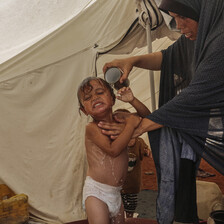The Electronic Intifada 6 February 2025

A Palestinian woman sits on the ruins of her home in Rafah, southern Gaza, on 21 January.
ActiveStillsIsrael’s overt assault on Gaza has ended, at least for now. The sounds of planes and whistles of shells have stopped, as have the moments of sheer terror and hiding from Israel’s attacks.
But the ceasefire has left behind a new life no less harsh than the war itself. It is a life filled with daily challenges, as though Israel never dropped its weapons, replacing them with battles that creep into all aspects of life.
Now the people of Gaza are enduring a new struggle – a struggle to search for a life worth living amid the rubble of homes, disfigured streets and dreams buried beneath the debris. It is a war of patience and perseverance in the absence of any clear reconstruction plans. There are no quick solutions, only people fighting to survive and refusing to surrender to ruin.
Huge challenges
Imagine attempting to leave your home, only to find that the road before you is nothing but wreckage. Streets that once buzzed with activity and life are now a maze of rubble and craters. The streets are no longer navigable; even the drivers of ambulances and humanitarian aid struggle to reach devastated neighborhoods.
The simplest daily tasks, like walking to a store or visiting a relative, have become huge challenges. Rubble is not just shattered stones; it is a silent testimony to a war that left profound marks on every corner and in every street. Restoring these roads could take years, maybe even generations.
The absence of electricity is another inescapable cause of suffering. Even before the war, electricity was available for only a few hours a day. Now it is nearly nonexistent. Neighborhoods subsist in darkness. Generators, once a familiar last resort, have become a rare luxury due to fuel shortages.
Night in Gaza is a battle with the dark. Children study by candlelight while mothers struggle to manage household affairs.
The lack of water, an essential element of life, remains a daily crisis in Gaza. When Israel cut off water supplies and destroyed desalination and distribution plants, it left countless families without access to clean water.
Some people rely on purchasing exorbitantly priced water from mobile tankers; others resort to well water, knowing it may be contaminated and unsafe to drink. Children carry heavy water containers over long distances. Thirst is no longer fleeting but a constant ache that afflicts everyone.
Perhaps the most painful scene in Gaza after the ceasefire is that of destroyed homes. Residential neighborhoods have been turned into piles of rubble, rendering their former inhabitants homeless.
Temporary shelters and schools have become homes for families who lost everything, including privacy, comfort and stability.
Determination
Despite all this destruction and pain, Gaza continues to resist. Each day is a battle to find water, to access electricity, to remove rubble – and the even greater battle to rebuild the self and assert our human dignity.
Life in Gaza after the war is not easy. But there is a deep belief that all this pain will one day be a distant memory. With determination, we will rebuild everything that has been destroyed – not only in the streets but also in our hearts.
The road forward is long and arduous. But this land, which has paid a heavy price time and again, will return to life once more. The people of Gaza do not know the meaning of the impossible, nor will we accept Israel’s destruction as the end.
Saeda Hamdona is a translator and English teacher in Gaza.





